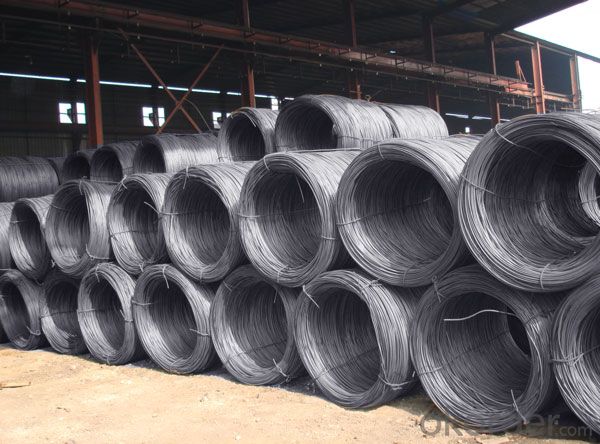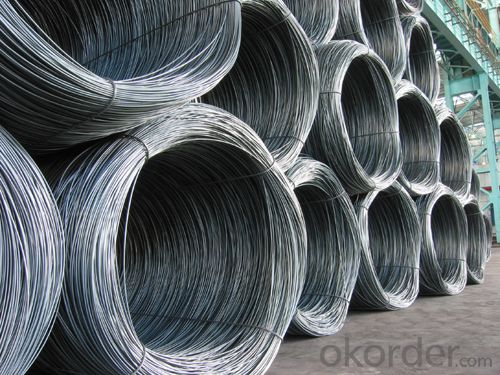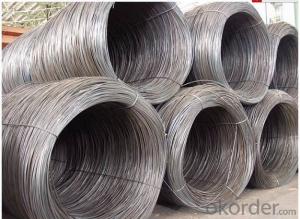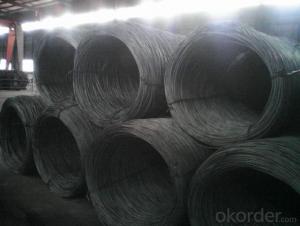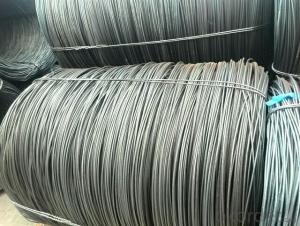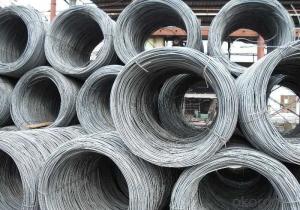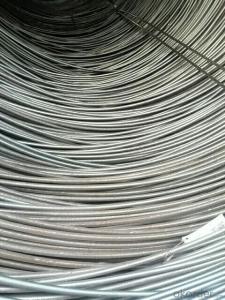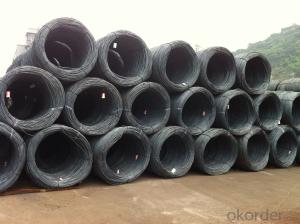Hot rolled high quality wire rod SAE1008 SAE1006
- Loading Port:
- Shanghai
- Payment Terms:
- TT OR LC
- Min Order Qty:
- 25 m.t.
- Supply Capability:
- 20000000 m.t./month
OKorder Service Pledge
OKorder Financial Service
You Might Also Like
WIRE ROD Details:
| Minimum Order Quantity: | m.t. | Unit: | m.t. | Loading Port: | |
| Supply Ability: | m.t./month | Payment Terms: | TT OR LC |
Product Description:
Steel Grade: Q195 Standard: ASTM, GB
Diameter: 5.5mm, 6.5mm, 7mm,8mm,9mm,10mm,12mm,14mm
6.5mm can be drawing into 2mm/8.0mm can be drawing into 3mm
Type: Drawn Wire in Coil, each coil weight about 2MT
Brand Name: N-RIVER Place of Origin: Hebei, China
Chemical Composition:
Please kindly find our chemistry of our material based on Q195 as below for your information
Trademark | Rank | Chemical composition (quality score) % | |||||
C | Si | Mn | S | P | |||
≤ | ≤ | ≤ | |||||
Q195 | 0.06-0.12 | 0.30 | 0.25 | 0.050 | 0.045 | ||
Trademark | Rank | Pulling Test | |||||
Bend PointΔs/Mpa | Tensile Strength | Elongation Ratioδ5% | |||||
Thickness (Diameter) /MM | Thickness (Diameter) /MM | ||||||
≤16 | 16-40 | ≤16 | 16-40 | ||||
≥ | ≥ | ||||||
Q195 | 195 | 185 | 315-390 | 33 | 32 | ||
Usage and Applications of Wire Rod Q195:
After hot-rolled the products shaped into coil and delivery as finished product, including round, square, rectangular, hexagonal and so on. Since most of the products are round, it is generally called wire rod. Carbon steel wire rod is widely used in construction and manufacturing. Carbon steel wire rod is mainly used for reinforcement of reinforced concrete and welded structure or reprocessed (roberts , nail, etc.) materials, especially used to produce wire drawing, welding electrode, nails, spring, electronic, precise machinery parts and so on
Wire Rod in Container
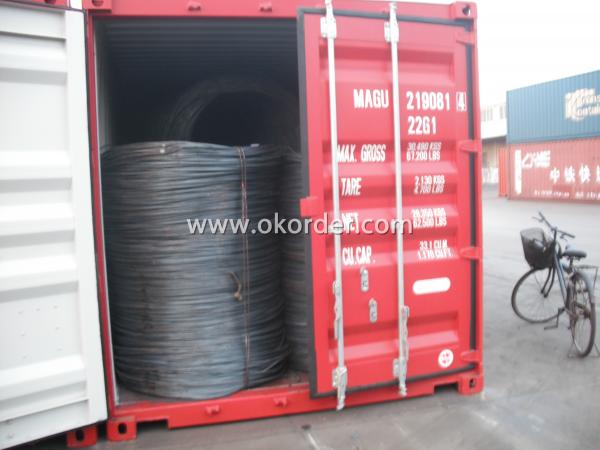
Wire Rod in Bulk Vessel
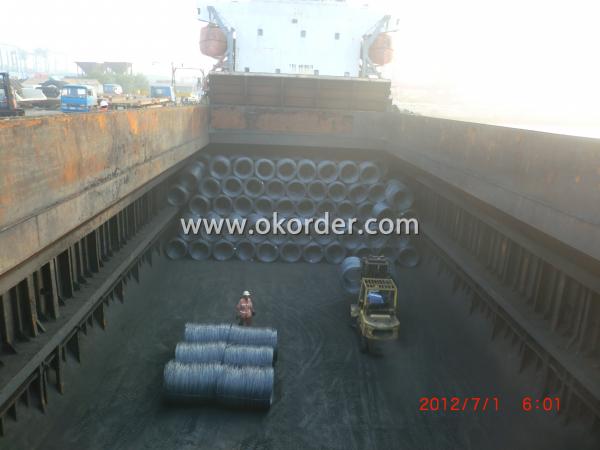
Note:
- Q: How is the dimensional accuracy of steel wire rod ensured?
- The dimensional accuracy of steel wire rod is ensured through a series of manufacturing and quality control processes. Firstly, the steel wire rod is produced using a continuous casting or hot rolling method, where the dimensions are closely monitored and controlled. This initial process ensures that the diameter and shape of the wire rod are within the desired tolerances. Once the wire rod is formed, it undergoes various mechanical treatments such as drawing, annealing, and cooling. These processes further refine the dimensions and improve the mechanical properties of the wire rod. Drawing involves pulling the wire rod through a series of dies with progressively smaller diameters, which helps in achieving the desired diameter with high precision. During the manufacturing process, regular inspections and measurements are carried out to ensure the dimensional accuracy of the wire rod. This includes using advanced measurement techniques such as laser-based measuring systems or optical scanners to check the diameter, roundness, and surface quality of the wire rod. Additionally, quality control procedures are implemented to ensure that the wire rod meets the required dimensional standards. This involves taking samples at regular intervals and measuring their dimensions to verify compliance with the specified tolerances. Any deviations from the desired dimensions are identified and appropriate corrective actions are taken to maintain the dimensional accuracy. Overall, the dimensional accuracy of steel wire rod is ensured through a combination of precise manufacturing techniques, mechanical treatments, regular inspections, and quality control procedures. These measures guarantee that the wire rod meets the dimensional requirements for its intended applications.
- Q: How is steel wire rod used in the production of wire mesh for industrial sieving?
- Steel wire rod is a crucial component in the production of wire mesh for industrial sieving. Wire mesh is commonly used in various industries, such as mining, construction, and agriculture, for the purpose of separating and classifying different materials based on their size and shape. The steel wire rod serves as the raw material for wire mesh production. It is first processed through a series of manufacturing steps to transform it into a suitable form for creating the mesh. The wire rod is typically drawn through a series of dies to reduce its diameter and increase its length. This process is known as wire drawing and results in a thin and elongated wire. Once the wire rod has been drawn, it is then woven or welded together to form the wire mesh. The weaving process involves interlacing the wires in a crisscross pattern, creating a strong and durable mesh structure. On the other hand, the welding process involves fusing the wires together at their intersections using heat or pressure, resulting in a solid and stable mesh. The choice between weaving and welding depends on the specific requirements of the application. Weaving is commonly used for producing wire mesh with smaller openings and finer mesh sizes, while welding is preferred for larger openings and heavier wire diameters. The wire mesh produced from steel wire rod offers several advantages for industrial sieving. Firstly, steel is a highly durable and robust material, capable of withstanding harsh environments and heavy loads. This ensures that the wire mesh can endure the constant impact of materials during the sieving process without losing its structural integrity. Additionally, steel wire rod provides excellent tensile strength, allowing the wire mesh to maintain its shape and resist deformation under tension. This is particularly important for applications that involve high-pressure sieving or require the mesh to be stretched tightly over a frame. Moreover, steel wire rod can be manufactured with different coatings or treatments to enhance its resistance to corrosion, abrasion, or other forms of wear and tear. This further extends the lifespan of the wire mesh, making it suitable for long-term industrial use. In summary, steel wire rod is an essential component in the production of wire mesh for industrial sieving. Its versatility, durability, and strength make it an ideal raw material for creating wire mesh that can withstand rigorous sieving applications in various industries.
- Q: How is steel wire rod used in the production of wire mesh partitions?
- Wire mesh partitions rely heavily on steel wire rod, which is essential for their production. These partitions find widespread use in industrial warehouses, commercial spaces, and even residential areas. The raw material for manufacturing the wire mesh used in these partitions is steel wire rod. This wire rod is typically made of high-quality steel, ensuring durability, strength, and resistance to corrosion. These properties play a crucial role in guaranteeing the long-lasting and reliable nature of the wire mesh partitions. To manufacture wire mesh partitions, the steel wire rod goes through a series of manufacturing processes. Initially, the wire rod is drawn through dies to decrease its diameter and increase its length. This process, known as wire drawing, results in a thinner and longer wire that is more suitable for weaving. Following the wire drawing process, the wire is woven into a mesh pattern using a specialized machine. Depending on the desired characteristics of the wire mesh partition, the weaving process can be done in various patterns such as plain weave, twill weave, or Dutch weave. This interlocking process creates a strong and stable mesh structure. After the wire mesh is woven, it may undergo additional processes such as galvanization or coating to enhance its resistance to corrosion or provide a specific finish. Galvanization involves applying a layer of zinc to the wire mesh, which acts as a protective barrier against rust and other environmental factors. Once the wire mesh is prepared, it is cut, shaped, and assembled to form the partitions. The wire mesh is securely attached to a frame made of metal or other materials, resulting in a sturdy and secure partition system. These partitions can be customized to fit specific spaces and requirements, offering efficient storage, security, and separation of areas. To summarize, steel wire rod plays a vital role in the production of wire mesh partitions. It serves as the raw material and provides the necessary strength, durability, and resistance to corrosion. Through various manufacturing processes, the steel wire rod is transformed into a woven mesh pattern, which is then shaped and assembled into wire mesh partitions for a wide range of applications.
- Q: What are the standard straightness requirements for steel wire rod?
- The steel wire rod typically adheres to industry standards or customer specifications to maintain its standard straightness. These requirements are crucial in ensuring that the wire rod has a uniform and straight shape, which is essential for its intended uses. One common requirement for steel wire rod straightness is the maximum allowable deviation from a straight line. This is usually expressed as the maximum bow or camber, indicating the amount of deviation when the wire rod is laid flat on a surface. Meeting this requirement ensures that the wire rod can be easily processed and utilized in various manufacturing processes like drawing, cold heading, or welding. Another straightness requirement for steel wire rod is the maximum permissible twist or helix. This refers to the amount of rotational or spiral distortion along the wire rod's length. Excessive twist can negatively impact the wire rod's performance, particularly in applications where it needs to be threaded through tight spaces or used in precision machinery. Moreover, specific tolerances for straightness may exist for different sections or lengths of the wire rod. For instance, the requirement for straightness might be more stringent at the ends or specific portions of the wire rod. These variations in straightness requirements are often determined based on the wire rod's intended application or the customer's specific needs. Overall, the standard straightness requirements for steel wire rod aim to ensure that the product meets the necessary quality standards and can be effectively utilized in various manufacturing processes. Adhering to these requirements guarantees that the wire rod performs consistently and reliably in its intended applications.
- Q: What are the different welding processes used for steel wire rod?
- There are several different welding processes used for steel wire rod, including gas metal arc welding (GMAW), flux-cored arc welding (FCAW), gas tungsten arc welding (GTAW), and submerged arc welding (SAW). Each process has its own advantages and is chosen based on factors such as the thickness of the wire rod, the desired weld quality, and the efficiency of the process.
- Q: What are the common production processes for bohrium-coated steel wire rod?
- The common production processes for bohrium-coated steel wire rod include wire drawing, cleaning and coating, heat treatment, and final inspection.
- Q: What are the common production processes for zinc-coated steel wire rod?
- The common production processes for zinc-coated steel wire rod include cleaning and pickling the steel wire rod, coating it with a layer of zinc through hot-dip galvanizing or electro-galvanizing, and finally, coiling the zinc-coated wire rod for packaging and transportation.
- Q: How is the steel wire rod market affected by political and economic instability?
- The steel wire rod market can be greatly influenced by political and economic instability. To begin with, changes in government, political unrest, or conflicts can disrupt the overall business environment. This uncertainty and policy changes can impact the demand and supply dynamics in the steel wire rod market. Additionally, economic instability, such as recessions, inflation, or currency fluctuations, can directly affect the steel wire rod market. During economic downturns, construction and infrastructure projects may be postponed or canceled, resulting in a decrease in demand for steel wire rods. Similarly, fluctuating exchange rates can impact the competitiveness of steel wire rod producers in the global market, potentially affecting export volumes and prices. Furthermore, political and economic instability can lead to a lack of investor confidence, which may result in reduced investment in new steel wire rod production facilities or the modernization of existing ones. This limitation can hinder the industry's ability to expand capacity or improve operational efficiency, ultimately affecting market growth and competitiveness. Moreover, political and economic instability can disrupt global supply chains, affecting the availability of raw materials and transportation logistics. Steel wire rod manufacturers heavily rely on raw materials like iron ore and coal, as well as efficient transportation networks to deliver products to customers. Any disruptions in these areas can result in increased costs and logistical challenges, which can negatively impact the market. In conclusion, political and economic stability are crucial for the steel wire rod market to thrive. A stable political environment ensures consistent policies and regulations, creating a favorable business climate. Simultaneously, economic stability provides a predictable market environment, encouraging investment and maintaining steady demand for steel wire rods.
- Q: How are steel wire rods used in the manufacturing of piano strings for musical instruments?
- Steel wire rods are used in the manufacturing of piano strings for musical instruments by being drawn through a series of dies to achieve the desired thickness and strength. These wire rods are then wound tightly around a core wire to create the piano string. The high tensile strength of steel wire makes it ideal for withstanding the tension required to produce the desired pitch and resonance in a piano.
- Q: What are the different types of steel wire rod finishes for improved adhesion in rubber products?
- There are several types of steel wire rod finishes that can enhance adhesion in rubber products. Some common finishes include copper, zinc, phosphate, and brass coatings. These finishes help to create a stronger bond between the steel wire rod and the rubber, improving adhesion and overall product performance.
Send your message to us
Hot rolled high quality wire rod SAE1008 SAE1006
- Loading Port:
- Shanghai
- Payment Terms:
- TT OR LC
- Min Order Qty:
- 25 m.t.
- Supply Capability:
- 20000000 m.t./month
OKorder Service Pledge
OKorder Financial Service
Similar products
Hot products
Hot Searches
Related keywords



